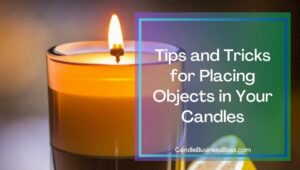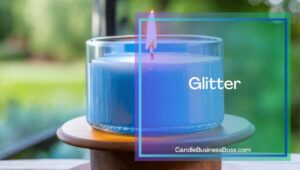With candle making a $2 million industry, there’s no question that there’s money to be made when making your own candles. Whether you want to create a business with your hobby or stick with making candles for your friends and family, there will come a time when you want to spice up your designs by adding objects inside. But what works best for additions to your candles? Are there things to avoid?
Some of the objects you can put in your candle are:
- Flowers and Herbs
- Dried Fruit
- Coffee Beans
- Glitter
- Crystals
- Jewelry
- Figurines and Rocks
What objects are safe, and what should you avoid? What kind of wax should you use when placing objects in your candles? Are there a particular style of candle that works best? Read on to find out more.
Tips and Tricks for Placing Objects in Your Candles
Before you decide to place objects inside your candles, there are a few things you should know. Firstly, when considering your wax type, you might think you are limited to a certain type of wax when placing items in your candles, but that is untrue—you can place items in any sort of wax candle. If you want to be able to see the items through your candle or container, though, make sure to use a see-through container and a gel wax for the best results.
Putting items in your candles is safe. You can put objects in your candles as long as any flammable material is positioned away from the wick and open flame. Items like flowers can catch fire and burn, along with produce smoke, which if you’re selling your candles, may create an issue of compliance for your brand. If the item is not combustible and comes in contact with the wick, it could also extinguish the flame, meaning your candle just won’t burn.

When considering what style of candle you want to use, sticking with the basics is best. Regardless of what you put in your candle, you want to be able to enjoy the objects inside while giving them enough room so they are not in the way of the wick, so larger candles like pillar candles or container candles are best to contain whatever objects you decide to place inside.
Whatever you choose to use, make sure it is non-toxic. A rule of thumb is that if it burns outside of your candle, it will burn inside your candle, so stay away from those items. Placing objects inside your candles can also cause bubbles in your wax. Avoiding bubbles is easy—warm your container before you pour your wax, and make sure you pour it as slowly as possible to avoid air getting trapped inside.
Also note that the bigger the item you want to embed, the bigger the candle needs to be. Smaller items like flowers, herbs, or glitter can be used in pillar candle molds, but more elaborate additions should be used in a container candle for best structural integrity.
But what items can you safely put in your candles? These seven items work best and safely inside homemade candles.
1. Flowers and Herbs
Flowers are a very easy way to add some interest to your candles. There are two ways to add flowers and plants to your candles—you can either mix them into the hot wax before you pour or be more deliberate in the mixture and add the flowers after the wax is poured into the final container.
One note about placing flowers or herbs is their natural scent! Whatever you decide to place in your candle may change the fragrance of that candle, so pick a fragrance or flower that is complementary to each other.
Your items should also be dried. Placing newly picked flowers in your wax could cause them to rot, which will just ruin your candle. When using herbs, those with fresh aromas are fantastic options—consider rosemary, thyme, or lavender for your candles.
2. Dried Fruit
Much like flowers, you can place dried fruit in your candles. Depending on what you use, make sure they are small enough to fit into the candle container. These objects must be dried thoroughly before use.
3. Coffee Beans
Yes, it’s possible to add coffee beans your candles—which make the perfect gift for that coffee-obsessed friend or family member. Because whole beans are already roasted and aren’t in danger of going bad, you can place whole beans into your candle. Consider using a coffee bean that has a flavor to it, which may add a fragrance to your candle.
4. Glitter

When it comes to glitter, you either love it or you hate it. Whether you like it or not, it’s a great additive to candles—if you use the right kind of glitter.
Because most craft glitter is made from polymer or a plastic material, it is created to be inflammable. This is a problem when you want it to burn, as if it gets hot, it could create toxic fumes or a fire hazard. To combat this, purchase non-flammable glitters for you candles. The finer the glitter, the better, as the smaller flecks will sit better in your candle.
Learn how to print designs on your candles!
5. Crystals
In this day and age when crystals have made a comeback, it’s no surprise that people want to put them in their candles. Many people believe in the energies put off by crystals, while others just like the look of their crystals in candles.
Regardless of the reason you like crystals, make sure it fits into the candle you are making. You do not want the crystals too close to the wick, as it could damage the crystal. You also should not use artificial gemstones, as they may not heat well inside the candle and could create a fire hazard. Natural gemstones are your best bet for this sort of craft.
6. Jewelry
There are companies all over selling candles and bath items with jewelry inside, like Fragrant Jewels or Jewelry Candles. You can make one of these candles too—just make sure you wrap the item in foil to prevent it from being damaged.
7. Figurines and Rocks
Gel candles are very popular when creating a candle with scenery inside, like a beach scene or nature scene. When creating candles like this, make sure to use clean, natural objects like stones in your candles. Using figurines or other types of additions should not be plastic—plastic could melt under the heat of the wax, ruining the candle and creating a toxic environment. Use objects that won’t melt, like stone or resin.
Shells are also fantastic options for your candles, but don’t use dried marine life. When you place them in wax, they could bloat and create issues in your candle.
When it comes to making candles, safety is key. This doesn’t change when you place objects inside your candles—in fact, you should be even more careful when making them. As long as the item does not catch fire or melt under direct hot wax, you can most likely place it into the candle. Make sure your items are clean and non-toxic and keep them away from the wick for best results.
Related Questions

What wicks work best in most candle types?
If you like to change up your wax types but want to use the best wick for all of them, using the most common type of zinc core wicks will maintain consistency between your wax types. It is the most popular to use and works best in all candle types. If you’re placing anything inside your candles, do not use wood wicks, as they can create a larger flame and could set your objects on fire.
What containers work best for beginner candles?
Whether you’re just making candles as a hobby or have an intent to sell, you should err towards using a glass or metal jar that is rated and tested for candles. There are standards in place by the ASTM International; if you decide to sell your candles, they should be within those standards. If you are reusing a candle container from a reputable candle company, your containers should already be meeting those standards.
What kind of fragrance oil should I use in my candles?
You have two general options for what fragrance oil you can use in candles: one, you can use non-toxic fragrance made for candle making and crafts, or two, you can use essential oils. Do not use a fragrance such as a perfume, as it is not intended to burn and may create a fire hazard if used in a candle.
Can I use food coloring as dye in candles?
No, you cannot use food coloring as candle dye. If you try to use it, it will not mix into the candle wax—most food colorings are made from glycerin and propylene glycol, which mix with water, not wax. Stick with dyes that are created specifically for candle making.
Considering starting your own candle making business. Click this link to checkout my startup documents here.
Please note that the contents of this blog are for informational and entertainment purposes only and should not be construed as legal advice. Any action taken based on the information provided in this blog is solely at your own risk. Additionally, all images used in this blog are generated under the CC0 license of Creative Commons, which means they are free to use for any purpose without attribution.

Meet Shawn Chun: Entrepreneur and Candle Business Fan.
I’m a happy individual who happens to be an entrepreneur. I have owned several types of businesses in my life from a coffee shop to an import and export business to an online review business plus a few more and now I create online candle business resources for those interested in starting new ventures. It’s demanding work but I love it. I do it for those passionate about their business and their goals. That’s why when I meet a candle business owner at a craft fair, farmers market, retail location or anywhere else I see myself. I know how hard the struggle is to obtain and retain clients, finding good employees all while trying to stay competitive. That’s why I created Candle Business Boss: I want to help candle business owners like you build a thriving business that brings you endless joy and supports your ideal lifestyle.

